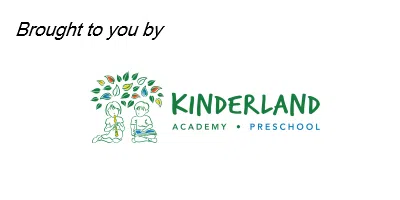BRANDED CONTENT
Coding, KinderFit, musical play: How preschool’s diverse curriculum is nurturing confident, creative children
At Kinderland Academy and Preschool, children learn Stem concepts as early as nursery through screen-free robotics, while also building life skills through a mix of interactive programmes
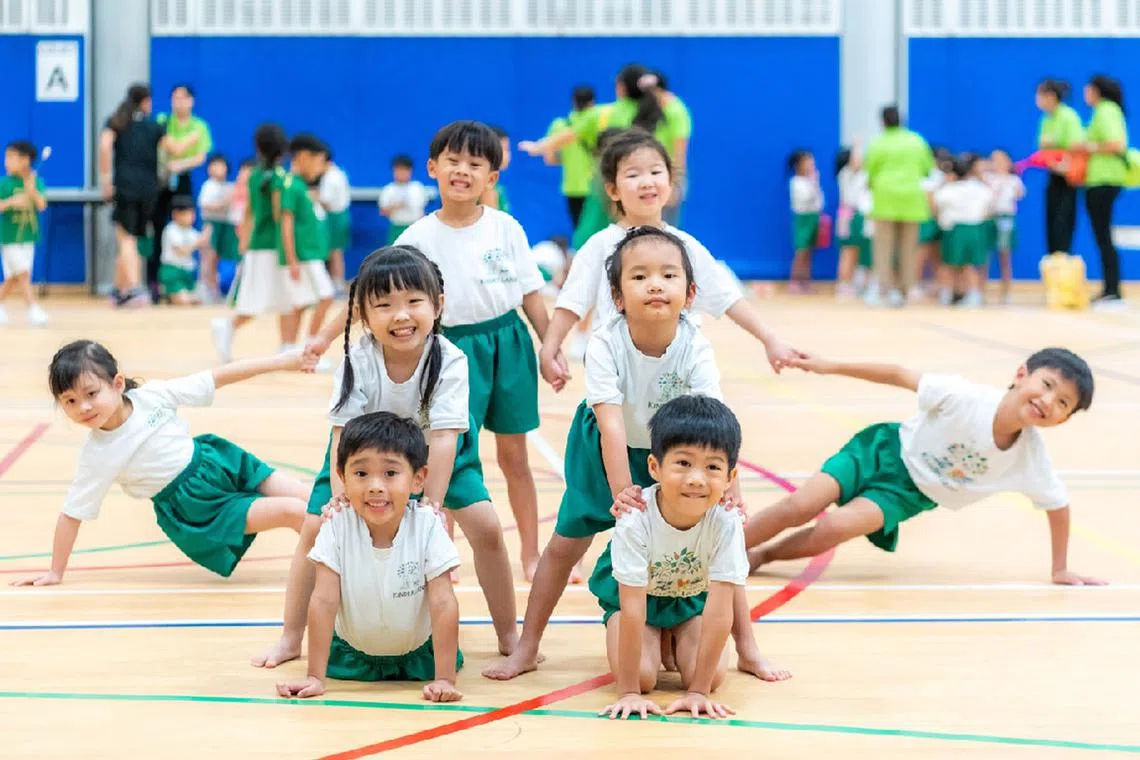
KinderFit sessions build teamwork and coordination while combining movement, fun and healthy habits. PHOTO: KINDERLAND
Follow topic:
Whenever Mr Eldric Chew sends his two sons to preschool, it is like a trip down memory lane. The 37-year-old also attended Kinderland
In fact, when he enrolled his older son, Enzo, now 6, back in 2020 in infant care, he recognised a teacher who had been with Kinderland since he was a preschooler there.
He recalls the preschool’s strong music focus and bilingual approach
One new offering is coding, which surprised the father-of-two. His younger son, Eizen, four, also attends Kinderland.
“Interestingly enough, because I’m in the robotics industry, I was amazed that my kids would actually get to know what I’m doing,” says Mr Chew who is a global head of business development for a robotics software management company.
“After learning about a cleaning robot in school, Enzo actually explained to me how it works instead of me explaining it to him.”
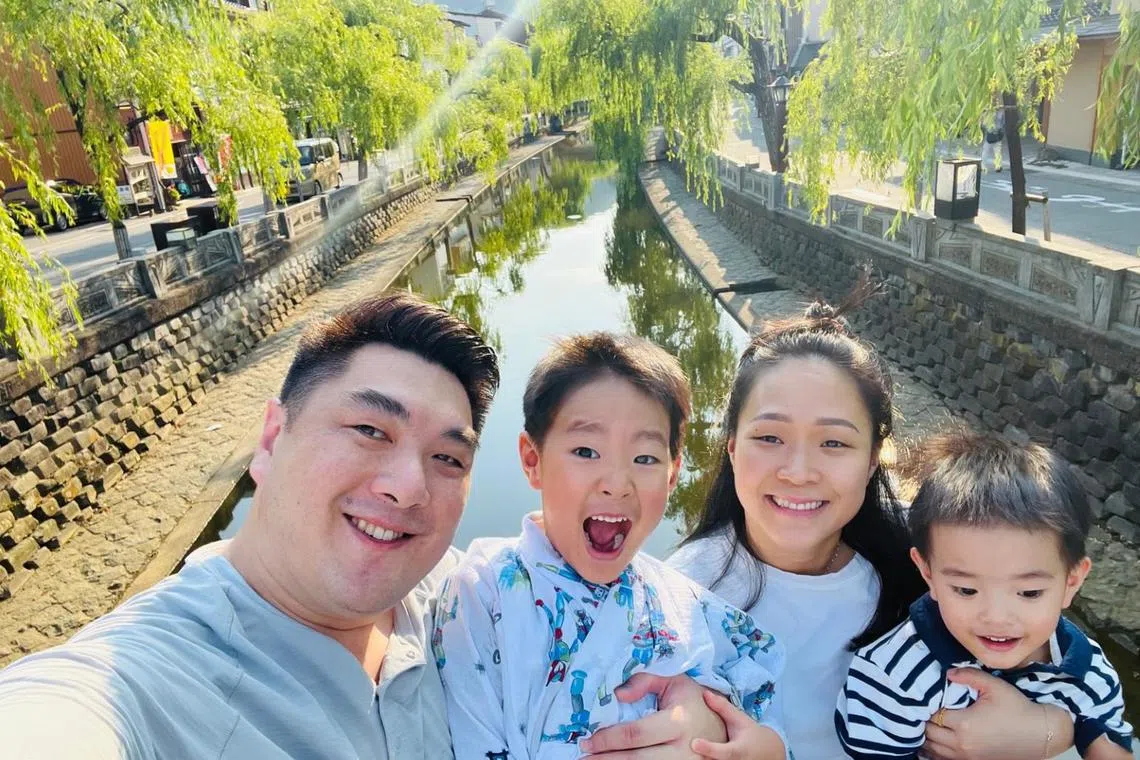
Former Kinderland student and dad, Mr Eldric Chew (left) sends both his sons to his alma mater.
At Kinderland, children begin weekly coding classes as early as nursery. They first explore screen-free coding using toys such as blocks, Legos and a robot mouse that teach basic logic and sequencing. By kindergarten 2 (K2), they progress to independently creating interactive stories using simple drag-and-drop code blocks on a tablet, capped at just 30 minutes per session.
Dr Carol Loy, senior director of curriculum and professional development at Kinderland International Education, shares: “We introduced screen-free coding in 2019 to help young children prepare for a tech-driven future. They learn to break down tasks into simple steps, give commands to move a toy from one point to another, and work together to solve problems.
”She adds: “Through this, we’ve observed enhanced problem-solving abilities, improved teamwork and communication skills, and increased confidence in tackling new challenges.”
Growing character and confidence
At Kinderland, screen time is used purposefully, never passively. Apart from coding with tablets in K2, the preschool’s Literacy through IT programme introduces screens only when needed – and always in age-appropriate ways.
For instance, children begin using computers from K1 to conduct simple topic research while under educators’ supervision, says Dr Loy.
“Before learning to operate the computers, our children are guided by educators,” she explains. “These early conversations help them develop a healthy sense of digital responsibility.”
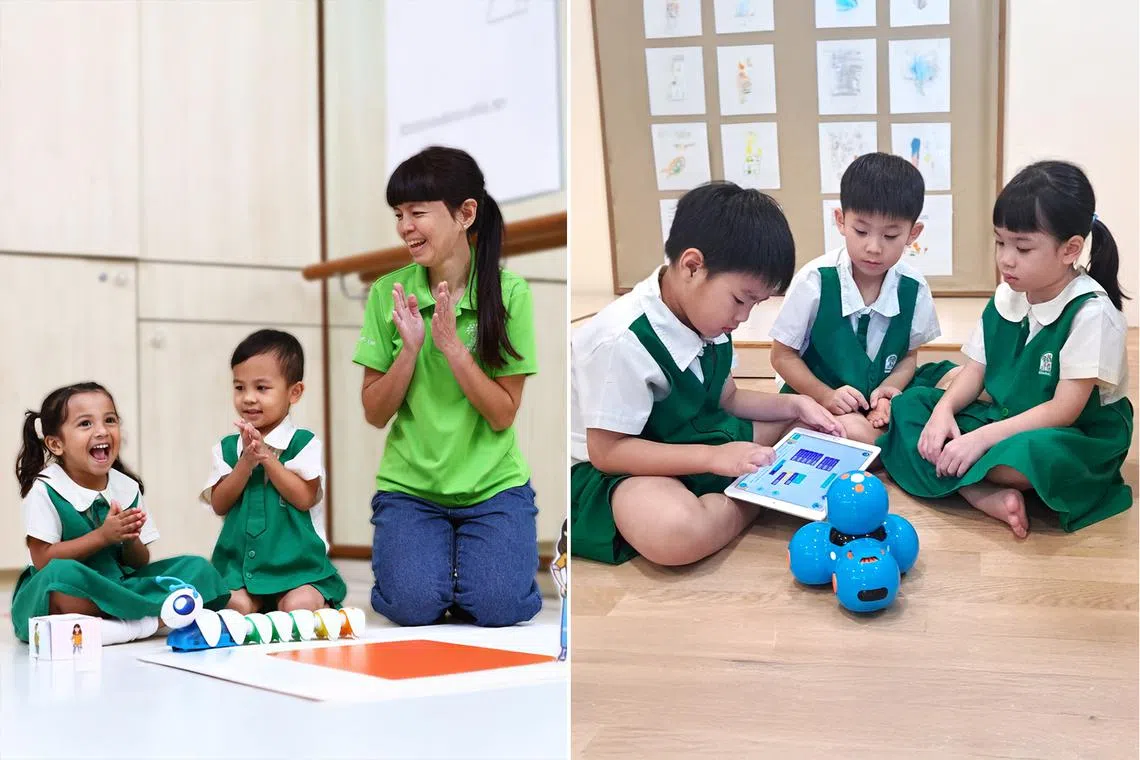
From hands-on coding toys to tablet-based story programming, students explore both screen-free and digital ways to learn logic, sequencing, and creativity. PHOTO: KINDERLAND
This head start is something Mr Chew appreciates. Spending much of his own time in front of screens – whether for work or managing his smart home – he is glad his sons use technology as a tool, not just for entertainment.
Fellow parent, Ms Samantha Tan, 39, shares this sentiment. Her son Matthew, in K1 at Kinderland’s Ministry of Manpower (MOM) branch, has taken to screen-free coding with enthusiasm. At home, he even uses Lego bricks to “code” instructions – assigning actions to each colour and involving the whole family in the fun.
“The coding programme at Kinderland teaches them to work together and solve problems,” says Ms Tan, an assistant sales director. “They learn to verbalise their thoughts, communicate with their teachers and peers, and collaborate to find the best solution.”
She observes that Matthew has also picked up something less tangible but just as valuable: Resilience. Ms Tan recalls him telling her: “Mummy, you must never give up when it’s hard. You must try again. It’s okay to make mistakes. Sometimes the mouse (coding toy) can go left or right and you get it wrong. But it’s okay. You can try again.”
Nurturing the whole child
Coding aside, the focus at Kinderland goes beyond just tech-readiness. The preschool’s curriculum is designed to nurture children across multiple domains – cognitive, physical, emotional and social.
Shares Dr Loy: “A child’s brain develops most rapidly between birth and age five. By taking a holistic approach to education, which includes music, literacy, fitness, Stream (Science, Technology, Reading and writing, Engineering, Arts and Mathematics), and character development, various areas of the brain are actively engaged, boosting cognitive functions such as problem-solving, language skills, and emotional regulation.”
Building on this approach is KinderFit (see sidebar for more information), a programme that supports children’s overall well-being through fun activities that get them moving and teach healthy habits.
Music – a core element of a Kinderland education – is also woven into the curriculum. Dr Loy shares that melodies engage children, keep them motivated and help them stay focused during activities.
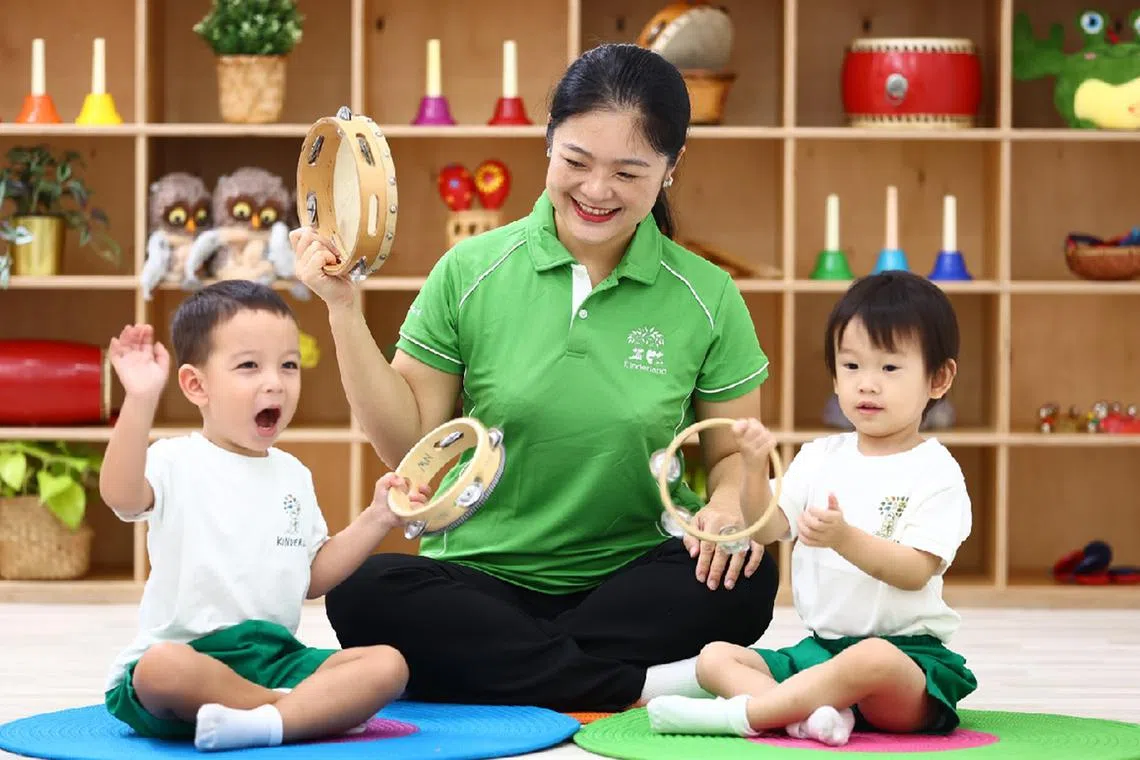
Through Kinderland’s music programme, children explore rhythm, melody, and self-expression. PHOTO: KINDERLAND
“Backed by research, our music-infused curriculum was introduced to enhance brain development, support language acquisition, and foster emotional expression,” she notes. “Music also helps develop fine and gross motor skills, cultivates creativity, and improves social interaction, making it a powerful learning tool across all domains of development.”
At Kinderland, formal music lessons are conducted once a week for children from pre-nursery 2 (PN2) to K2, which includes keyboard lessons and specific instruments such as the pianica that builds breath control and finger coordination, as well as the electone which improves hand-eye coordination and recognising patterns.
Mum Diana Tan values how Kinderland’s music-infused curriculum complements the piano lessons that her children attend privately. One of them has since graduated from Kinderland, while the other is at Kinderland’s Hougang branch.

Six-year-old Kinderland student Asher (second from right) made his public performance debut at a community event in 2024. PHOTO: KINDERLAND
Says the 41-year-old: “It’s important to balance academia with music. This really helps with language as well because they sing songs; and it helps with reading when they pick up the words. There’s also teamwork in the way music is taught at Kinderland.”
The human resources professional recalls with pride how her son Asher, 6, played in an ensemble at a community National Day dinner last August – his first-ever public performance. “He wasn’t the least bit nervous playing the tone bells alongside his K1 and K2 classmates. The confident and communicative children could even interact with the emcee.
“The children trained very hard, and were very enthusiastic to perform,” she adds. They were well-coordinated and sang loudly and confidently. Everything was well prepared thanks to the school and the teachers who were really encouraging.”
Fit, fun and full of moves

In addition to fitness and motor skill activities, some Kinderland schools also offer enrichment programmes like K-pop dance and rhythmic gymnastics. PHOTO: KINDERLAND
Twice a week, children from PN2 to K2 participate in the KinderFit programme. This instills the importance of physical fitness, motor skill development, improved cardio wellness and healthy eating and nutrition habits, says Dr Carol Loy. She is the senior director of curriculum and professional development at Kinderland International Education.
To make fitness more fun, some Kinderland preschools offer enrichment programmes such as K-Pop dance classes and a rhythmic gymnastics class organised by a Japanese physical education enrichment school.
Adds Dr Loy: “We believe that a strong foundation in both gross and fine motor skills contributes not only to physical health, but also leads to better learning outcomes, coordination, and self-confidence in and outside the classroom.”
These benefits are evident to parent Eugenia Goh, 33, who has noticed positive changes in her sons Kieran, 5, and Lucian, 3. They both attend Kinderland’s Ministry of Manpower branch. She observes they are more agile, with better coordination, and KinderFit has also instilled in them a healthy understanding about body parts, especially in her older son.
To keep up with how well her sons are hitting their developmental milestones, the statistician refers to a checklist that Kinderland shares with parents every quarter.
Kinderland also has an in-house nutritionist who curates menus that offer balanced, nutritious meals aligned with the Health Promotion Board’s Healthy Meals in Preschools Programme (HMPP) guidelines and the preschool’s healthy eating lessons. This further reinforces what the children learn during their KinderFit lessons.
Learn more about how your child can get a head-start at Kinderland
